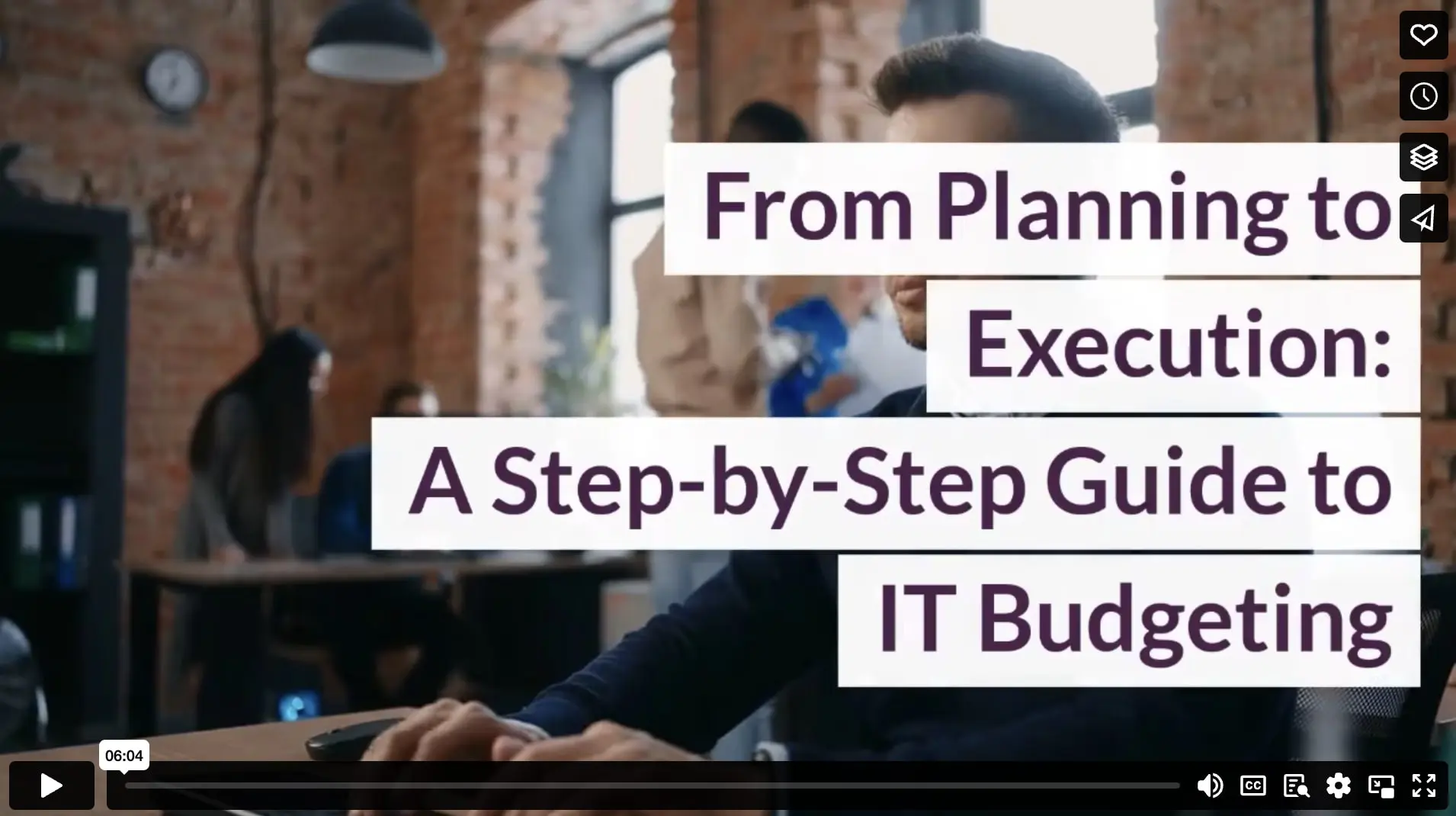Oh, the joys of IT budgeting—could it be any more complex?
Whether you’re rolling out new cloud-based access control or integrating advanced surveillance systems, it’s clear that IT budgeting goes beyond simple spreadsheets. The finance and IT departments often seem to be on different wavelengths, struggling to align on the fundamental aspects of budgeting. And let’s not forget the challenge of keeping up with the latest in business technology services and Microsoft 365 licensing adjustments.
The good news is, there are ways to make it all simpler. In this guide, we’ll show you everything you need to know about IT budgeting. We’ll cover the best practices, point out common mistakes to avoid, and introduce tools that can help your organization develop and stick to a strong budget.
What is IT Budgeting?
IT budgeting is the act of planning, allocating, and managing your company’s money for IT needs.
It involves developing a financial plan that outlines your spending for things like cloud-based access control, managed IT services, and business technology services. This includes costs for hardware, software, team members, and other expenses, typically over a year.
The size of your IT budget can vary significantly based on your company’s size, your industry, and your specific tech requirements. Think of it as a key component of your IT strategy—it’s crucial for fostering growth and improving how your business operates.
In essence, IT budgeting ensures you use your resources wisely, spending on IT resources as needed and keeping costs down where you can. It supports your business goals, drives innovation, and helps manage costs effectively.
How to Create an IT Budget?
Creating a strategic IT budget might seem complex, but it doesn’t have to be. Here’s how to approach it:
Review Past Spending
Get started by looking back at how you’ve spent on IT before. Understanding your past expenses helps you figure out what’s needed and what’s not, setting the stage for smarter planning as your business grows or changes.
Evaluate Your IT Setup
Take a good look at your current IT gear and software. Are they doing the job, or is it time for an upgrade? Keeping your tech up-to-date is crucial for running your operations smoothly.
Define Your Goals
Set clear goals for what you want your IT spending to achieve. Align your budget with your broader business objectives, whether that’s improving security, enhancing efficiency, or scaling up operations.
Bring Everyone Together
It’s important to include all key players in this process—from IT and finance to executives and department leaders. This collaboration ensures the budget reflects diverse needs and supports overall business strategies.
Categorize Your Spending
Organize your IT costs into clear categories. These might include:
- Staff training (to keep skills sharp)
- Technology upgrades (like newer systems or software)
- Maintenance (for ongoing system support)
- Project funding (for expanding tech capabilities)
Distribute Funds
Once you’ve laid out your costs, allocate your budget according to each category’s priority and its role in achieving business goals. Invest more in areas that will drive key outcomes.
Prepare for Surprises
Finally, set aside a portion of your budget for unexpected expenses. Whether it’s sudden repairs or seizing a new tech opportunity. A contingency fund keeps you prepared for costs you may not see coming.
IT Budgeting Pitfalls to Avoid
When you’re setting up your IT budget, there are a few things you really want to avoid to keep everything running smoothly.
Cutting Corners on Training
When you get new tech, it’s key to train your team on how to use it properly. If you skip this step, your team might not use the tech right, which can lead to expensive mistakes. It can also mean your team isn’t able to fully leverage the benefits of your new tech. Proper training means your team uses the tech effectively and keeps everything secure.
Not Keeping Track of Technology Resources
It might not seem like a big deal, but not keeping track of all your tech gear and software is a common slip-up. It takes effort, but it’s the only way to make sure everything is being used right and really helping your business.
Cutting Back on Services
When money’s tight, it’s tempting to go for cheaper services or downgrade your software. But think about what you’re giving up. Choosing cheaper options might save money now, but it could cost you more later if it means more breakdowns or less efficiency.
Ignoring Long-Term Costs of Cutting Back
When cash is short, cutting costs everywhere might seem like a good move. Like, maybe you backup your system less often. But if something goes wrong, you could lose important data that you can’t get back, which can really hurt your business later.
Steering clear of these pitfalls will help you set up an IT budget that works better for your business and avoids troubles down the road.
IT Budgeting Best Practices
Review Your Budget Regularly
Keep your IT budget relevant by checking it often. Changes in business priorities or market conditions might require adjustments. This ensures your budget always supports your current goals.
Align IT Spending with Business Objectives
Ensure every dollar spent on IT supports your business goals. From cloud-based security cameras to managed IT services, each investment should help your business grow, compete, and operate more efficiently.
Include a Contingency Fund
Prepare for the unexpected by adding a buffer to your budget. This flexibility allows you to handle surprises without going over budget or disrupting other planned activities.
Anticipate New Technology Needs
Stay ahead of the curve by budgeting for emerging technologies. Whether it’s exploring AI video surveillance or updating to web-based access control systems, being proactive keeps you competitive and ready for future challenges.
Prioritize Projects with High Impact
Focus your budget on IT projects that offer the best return on investment. Choose those that align with both your immediate needs and long-term strategy, ensuring they contribute significantly to your business.
Benchmark Against Industry Standards
Compare your IT expenses with similar organizations to find areas for improvement. Benchmarking helps you understand where you can save money or where you need to invest more to stay competitive.
Conclusion
Optimizing your IT budget is key to ensuring your spending aligns with your company’s goals. When you manage your IT budget effectively, every dollar contributes to your business objectives. Follow the steps above to streamline your processes, make informed decisions, and maximize the impact of every financial commitment within your IT department.
Video
Infographic
Implementing new cloud-based access control or integrating advanced surveillance systems requires more than simple spreadsheets. The finance and IT departments often struggle to align on budgeting. This infographic explores the best IT budgeting practices to simplify the process.





